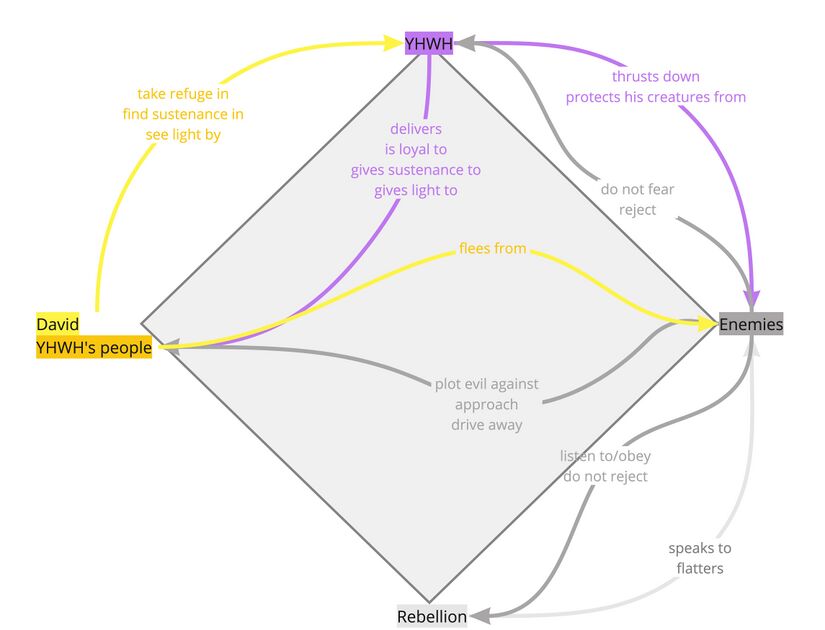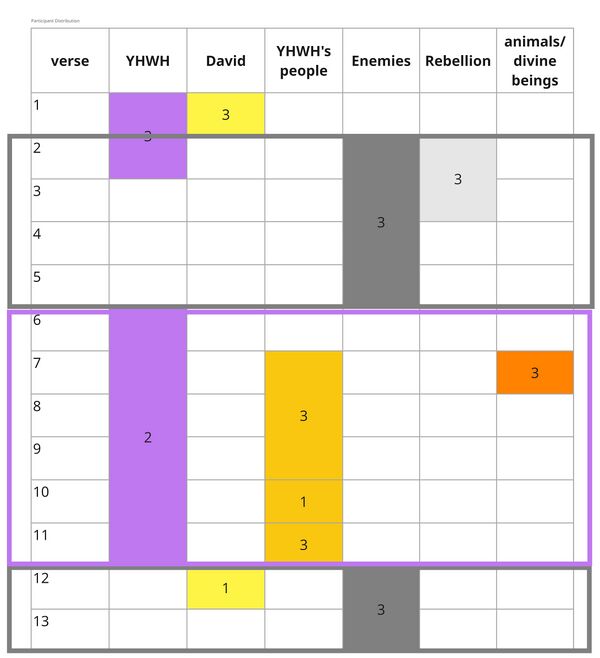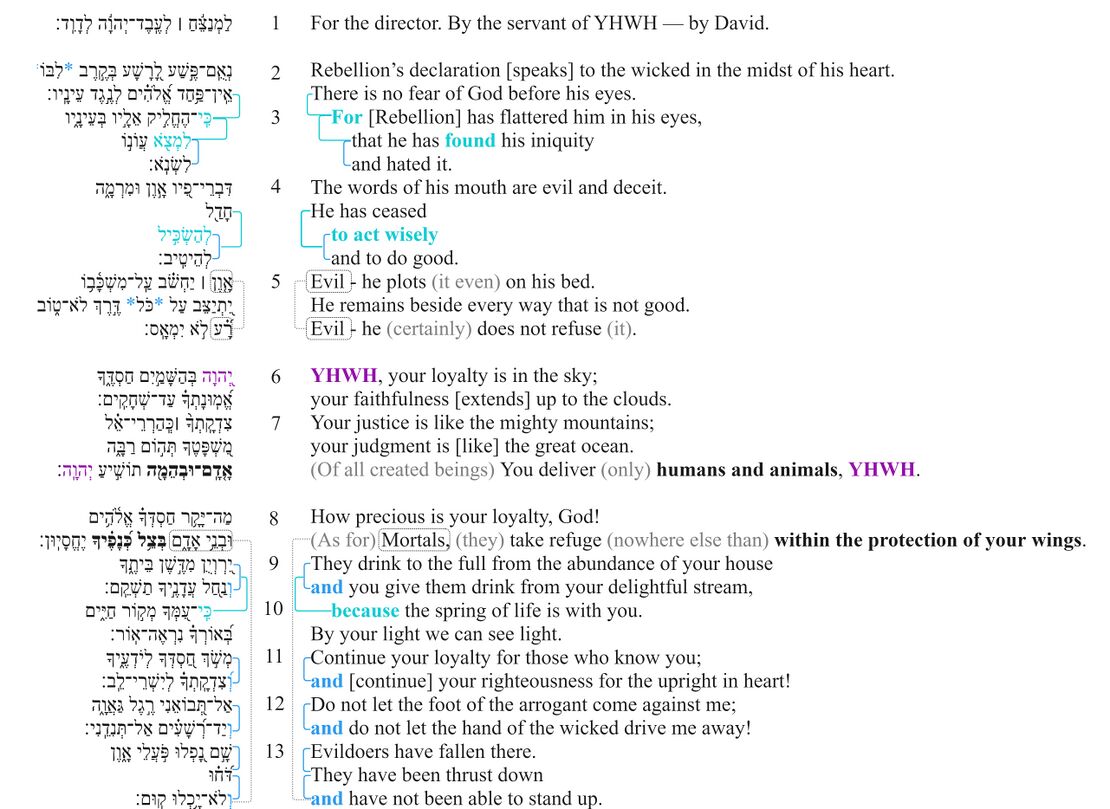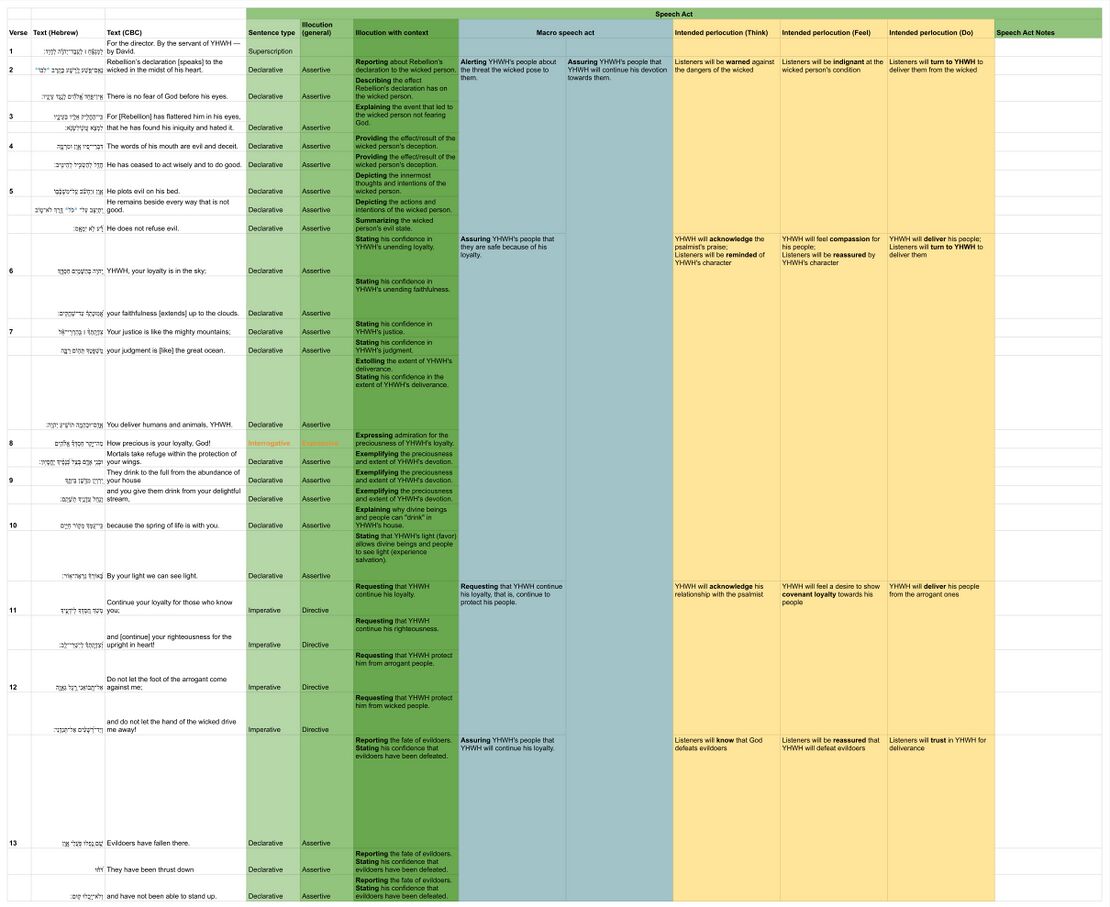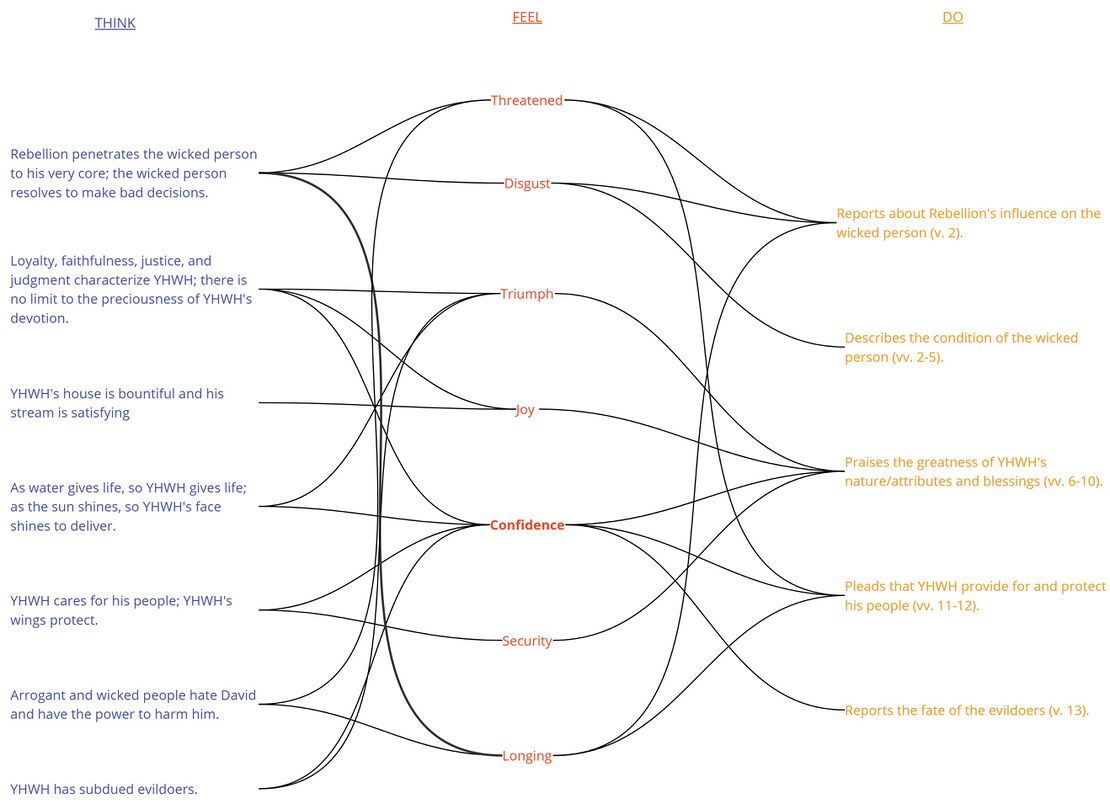Psalm 36 Discourse
About the Discourse Layer
Our Discourse Layer includes four additional layers of analysis:
- Participant analysis
- Macrosyntax
- Speech act analysis
- Emotional analysis
For more information on our method of analysis, click the expandable explanation button at the beginning of each layer.
Participant Analysis
Participant Analysis focuses on the characters in the psalm and asks, “Who are the main participants (or characters) in this psalm, and what are they saying or doing? It is often helpful for understanding literary structure, speaker identification, etc.
For a detailed explanation of our method, see the Participant Analysis Creator Guidelines.
There are 4 participants/characters in Psalm 36:
| David |
| "YHWH's servant" (v. 1) |
| YHWH's people |
| "those who know you" (v. 11) |
| "the upright in heart" (v. 11) |
| Humans |
| Mortals |
| YHWH |
| "God" (v. 8) |
| Animals |
| Enemies |
| "the wicked [person]" (v. 2) |
| "the arrogant [people]" (v. 12) |
| "the wicked [people]" (v. 12) |
| "evildoers" (v. 13) |
| Body Parts of Enemies |
| "the foot [of the arrogant]" (v. 12) |
| "the hand [of the wicked]" (v. 12) |
| Rebellion |
- Enemies: It is unclear whether the enemies in Ps 36 are from within (i.e., fellow Israelites) or without (i.e., foreign powers), yet the descriptions of YHWH's attributes and the allusions to the temple suggest that they are "criminally minded, powerful and arrogant Israelites or Judaeans" (Botha 2004, 518). A singular wicked person is the focus of vv. 2-5 and appears to be representative of a larger group referred to later as "arrogant" (v. 12), "wicked" (v. 12), and "evildoers" (v. 13) (cf. Botha 2004, 517; le Mat 1957, 68). The enemies set themselves up against YHWH and David (and, by extension, YHWH's people). Because of their hostility towards YHWH and his people, such enemies fall, are thrust down, and are not able to stand up (v. 13); in other words, they die.
- Rebellion: Rebellion is personified as an "inspiring demon" who, masquerading as a prophet, speaks to the wicked person (Gunkel 1926, 152; cf. Gen 4:7; Ps 119:133b) and flatters him (see The Syntax and Meaning of Psalm 36:3). Instead of listening to the נאם יהוה "declaration of YHWH," the wicked person heeds its antithesis — the נאם פשׁע "declaration of Rebellion."
- Animals: The mention of "humans and animals" (v. 7) could be meristic, encapsulating "the totality of living beings" (Botha 2004, 511n17; Hossfeld and Zenger 1993, 227). The inclusion of animals in v. 7 is fitting in light of the preceding creation language (e.g., sky, clouds, etc.). Here, as in other places (cf. Jonah 4:11; Pss 104:14; 147:9), YHWH demonstrates his concern for both humans and animals.
| Hebrew | Verse | English |
|---|---|---|
| לַמְנַצֵּ֬חַ ׀ לְעֶֽבֶד־יְהוָ֬ה לְדָוִֽד׃ | 1 | For the director. By the servant of YHWH — by David. |
| נְאֻֽם־פֶּ֣שַׁע לָ֭רָשָׁע בְּקֶ֣רֶב לִבוֹ | 2a | Rebellion’s declaration [speaks] to the wicked in the midst of his heart. |
| אֵֽין־פַּ֥חַד אֱ֝לֹהִ֗ים לְנֶ֣גֶד עֵינָֽיו׃ | 2b | There is no fear of God before his eyes. |
| כִּֽי־הֶחֱלִ֣יק אֵלָ֣יו בְּעֵינָ֑יו | 3a | For [Rebellion] has flattered him in his eyes, |
| לִמְצֹ֖א עֲוֺנ֣וֹ לִשְׂנֹֽא׃ | 3b | that he has found his iniquity and hated it. |
| דִּבְרֵי־פִ֭יו אָ֣וֶן וּמִרְמָ֑ה | 4a | The words of his mouth are evil and deceit. |
| חָדַ֖ל לְהַשְׂכִּ֣יל לְהֵיטִֽיב׃ | 4b | He has ceased to act wisely and to do good. |
| אָ֤וֶן ׀ יַחְשֹׁ֗ב עַֽל־מִשְׁכָּ֫ב֥וֹ | 5a | He plots evil on his bed. |
| יִ֭תְיַצֵּב עַל־כֹל דֶּ֣רֶךְ לֹא־ט֑וֹב | 5b | He remains beside every way that is not good. |
| רָ֝֗ע לֹ֣א יִמְאָֽס׃ | 5c | He does not refuse evil. |
| יְ֭הוָה בְּהַשָּׁמַ֣יִם חַסְדֶּ֑ךָ | 6a | YHWH, your loyalty is in the sky; |
| אֱ֝מֽוּנָתְךָ֗ עַד־שְׁחָקִֽים׃ | 6b | your faithfulness [extends] up to the clouds. |
| צִדְקָֽתְךָ֨ ׀ כְּֽהַרְרֵי־אֵ֗ל | 7a | Your justice is like the mighty mountains; |
| מִ֭שְׁפָּטֶךָ תְּה֣וֹם רַבָּ֑ה | 7b | your judgment is [like] the great ocean. |
| אָ֤דָֽם־וּבְהֵמָ֖ה תוֹשִׁ֣יעַ יְהוָֽה׃ | 7c | You deliver humans and animals, YHWH. |
| מַה־יָּקָ֥ר חַסְדְּךָ֗ אֱלֹ֫הִ֥ים | 8a | How precious is your loyalty, God! |
| וּבְנֵ֥י אָדָ֑ם בְּצֵ֥ל כְּ֝נָפֶ֗יךָ יֶחֱסָיֽוּן׃ | 8b | Mortals take refuge within the protection of your wings. |
| יִ֭רְוְיֻן מִדֶּ֣שֶׁן בֵּיתֶ֑ךָ | 9a | They drink to the full from the abundance of your house |
| וְנַ֖חַל עֲדָנֶ֣יךָ תַשְׁקֵֽם׃ | 9b | and you give them drink from your delightful stream, |
| כִּֽי־עִ֭מְּךָ מְק֣וֹר חַיִּ֑ים | 10a | Because the spring of life is with you. |
| בְּ֝אוֹרְךָ֗ נִרְאֶה־אֽוֹר׃ | 10b | By your light we can see light. |
| מְשֹׁ֣ךְ חַ֭סְדְּךָ לְיֹדְעֶ֑יךָ | 11a | Continue your loyalty for those who know you; |
| וְ֝צִדְקָֽתְךָ֗ לְיִשְׁרֵי־לֵֽב׃ | 11b | and [continue] your righteousness for the upright in heart! |
| אַל־תְּ֭בוֹאֵנִי רֶ֣גֶל גַּאֲוָ֑ה | 12a | Do not let the foot of the arrogant come against me; |
| וְיַד־רְ֝שָׁעִ֗ים אַל־תְּנִדֵֽנִי׃ | 12b | and do not let the hand of the wicked drive me away! |
| שָׁ֣ם נָ֭פְלוּ פֹּ֣עֲלֵי אָ֑וֶן | 13a | Evildoers have fallen there. |
| דֹּ֝ח֗וּ וְלֹא־יָ֥כְלוּ קֽוּם׃ | 13b | They have been thrust down and have not been able to stand up. |
vv. 2-5: The Identity of the Addressee
- Unlike vv. 6-12 which is addressed to YHWH, the addressee of vv. 2-5 is unspecified. Within the section addressed to YHWH, a group is referred to as "those who know you" (v. 11), and "the upright in heart" (v. 11). Taken together, these references suggest that "YHWH's people" are in view as the likely addressee of vv. 2-5. This is further evidenced by the juxtaposition of this group with "arrogant [people]" and "wicked [people]" (v. 12) (i.e., not YHWH's people; see Botha 2004).
v. 3a: The subject(s) and referent(s) of כִּי־הֶחֱלִיק אֵלָיו בְּעֵינָיו For he has flattered himself in his eyes
- For a fuller treatment of the participants involved in v. 3a, see The Syntax and Meaning of Ps. 36:3.
vv. 8-10: The subject(s) of יֶחֱסָיוּן, יִרְוְיֻן, and נִרְאֶה YHWH's people or both YHWH's people and Divine Beings?
- The subject(s) of three verbs is/are determined by whether אֱלֹהִים (v. 8) is grouped with the preceding clause as a vocative (so ESV) or the succeeding clause as part of a compound subject (so REB). If the former, the subject is בְנֵי אָדָם "people"; if the latter, the subjects are both בְנֵי אָדָם "people" and אֱלֹהִים "divine beings." The latter is preferred so that "divine beings and people" both "take refuge," "drink to the full," and "see" light. For a fuller treatment on the position of אֱלֹהִים, see The Division of Psalm 36:8.
- The person shift at v. 10, from third to first, most likely marks the end of a section (see de Regt 2000).
v. 13: The Identity of the Addressee
- That the addressee switches back to YHWH's people here, and does not continue with YHWH, is not signalled by an overt person-shift, for third-person language appears throughout vv. 12-13. Based on the parallels with v. 5 however, there is reason to believe that the psalmist stops addressing YHWH and begins to address YHWH's people again: both include a three-fold description of the wicked person(s) (with three verbs in each), along with a contrast between where the wicked person stands (v. 5b) and where he falls down (v. 13a; see Botha 2004, 516n30).
Participant Relations Diagram
The relationships among the participants may be abstracted and summarized as follows:
Macrosyntax
Macrosyntax Diagram
| Macrosyntax legend | |
|---|---|
| Vocatives | Vocatives are indicated by purple text. |
| Discourse marker | Discourse markers (such as כִּי, הִנֵּה, לָכֵן) are indicated by orange text. |
| The scope governed by the discourse marker is indicated by a dashed orange bracket connecting the discourse marker to its scope. | |
| The preceding discourse grounding the discourse marker is indicated by a solid orange bracket encompassing the relevant clauses. | |
| Subordinating conjunction | The subordinating conjunction is indicated by teal text. |
| Subordination is indicated by a solid teal bracket connecting the subordinating conjunction with the clause to which it is subordinate. | |
| Coordinating conjunction | The coordinating conjunction is indicated by blue text. |
| Coordination is indicated by a solid blue line connecting the coordinating clauses. | |
| Coordination without an explicit conjunction is indicated by a dashed blue line connecting the coordinated clauses. | |
| Marked topic is indicated by a black dashed rounded rectangle around the marked words. | |
| The scope of the activated topic is indicated by a black dashed bracket encompassing the relevant clauses. | |
| Marked focus or thetic sentence | Marked focus (if one constituent) or thetic sentences[1] are indicated by bold text. |
| Frame setters[2] are indicated by a solid gray rounded rectangle around the marked words. | |
| [blank line] | Discourse discontinuity is indicated by a blank line. |
| [indentation] | Syntactic subordination is indicated by indentation. |
| Direct speech is indicated by a solid black rectangle surrounding all relevant clauses. | |
| (text to elucidate the meaning of the macrosyntactic structures) | Within the CBC, any text elucidating the meaning of macrosyntax is indicated in gray text inside parentheses. |
If an emendation or revocalization is preferred, that emendation or revocalization will be marked in the Hebrew text of all the visuals.
| Emendations/Revocalizations legend | |
|---|---|
| *Emended text* | Emended text, text in which the consonants differ from the consonants of the Masoretic text, is indicated by blue asterisks on either side of the emendation. |
| *Revocalized text* | Revocalized text, text in which only the vowels differ from the vowels of the Masoretic text, is indicated by purple asterisks on either side of the revocalization. |
- The first section (vv. 2-5) is delimited based on its thematic unity as a description of the wicked person.
- The end of the first section and beginning of the second (vv. 6-7) is signaled by the vocative, יְהוָה. The second section extends until the occurrence of another vocative, יְהוָה, which signals the end of that section.
- The division between the second and third section (vv. 8-13) is strengthened, not only by the section-ending vocative in v. 7c, but by the exclamative statement in v. 8a. The discourse function of the exclamative statement, מַה־יָּקָר חַסְדְּךָ "How precious is your devotion!", may be similar to that of a rhetorical question in that it has the potential to "open or close a section and thus play a part in the (poetic) structuring of the text" (de Regt 1996, 75). Exclamative are similar to thetics in that both "convey[s] surprise," yet different in that exclamative presuppose a proposition whereas thetics do not (García Macías 2016, 79). In other words, "How precious is your devotion!" presupposes the proposition, "YHWH's devotion is precious," which is the very point the psalmist is at pains to demonstrate in the previous section (vv. 6-7). Based on macrosyntactic considerations, the psalm divides into three parts: vv. 2-5, 6-7, and 8-13.
- v. 5a - In the previous verse, the psalmist describes the wicked person's words as אָוֶן וּמִרְמָה "evil and deceit." As a result, these two characteristics are activated in the discourse and, hence, made available for selection in the following text. Of these two characteristics, the psalmist selects אָוֶן as the topic of the sentence, that is, what remainder of the sentence will be about. The remainder of the sentence relates new information about this topic; not only does the wicked person speak evil, but he even "plots [it] while on his bed."
- v. 5c - Similar to אָוֶן (v. 5a), the fronted constituent רָע represents the topic of the sentence. The rest of the sentence relates new information about it — the wicked person "(certainly) does not refuse [it]." Yet this instance of topic selection is different from אָוֶן in that רָע is not chosen from a previously activated set (such as אָוֶן from אָוֶן וּמִרְמָה). Instead, the psalmist selects רָע "from an open set of possible candidates for the role of topic" (Khan and Van der Merwe 2020, 25).
- v. 6a - The default word order for verbless clauses is subject-predicate (BHRG §46.2.3.1). This line exhibits non-default word order in that the predicate (בְּהַשָּׁמַיִם) appears before the subject (חַסְדֶּךָ), however the effect of this order is purely poetic, forming a chiasm with the following line: A (prep. phrase + noun, suffix) // B (noun, suffix + prep. phrase).
- v. 7c - The fronted אָדָם־וּבְהֵמָה "humans and animals" represents marked focus. The set of alternatives from which "humans and animals" are chosen is creation. The mention of "sky," "clouds," and "great deep" indicates that all of creation is in view, from which the psalmist selects only "humans and animals" as the beneficiaries of YHWH's deliverance (cf. "Selective Focus" in Khan and Van der Merwe 2020, 20-21).
- v. 8b - The fronted phrase, אֱלֹהִים וּבְנֵי אָדָם "divine beings and people," represents a topic shift. "Divine beings and people" are the subjects of vv. 8b, 9a, and are the direct objects of 9b. In vv. 8b and 9a the focus is on what is said about "divine beings and people" — they take refuge and drink to the full. As the direct objects of v. 9b, the focus is on the fact that they are given the river to drink from by YHWH. Also preposed before the verb is the prepositional phrase בְּצֵל כְּנָפֶיךָ "within the protection of your wings," which represents marked focus. The idea is that divine beings and people take refuge only within the protection of YHWH's wings.
- v. 9b - The non-default word order of this B line is for poetic effect, as it completes a chiasm begun in the A line: A (verb, adverbial + suffix) // B (adverbial + suffix, verb) (see Lunn 2006, 106).
- v. 10a - The default word order for verbless clauses is subject-predicate (BHRG §46.2.3.1). This line exhibits non-default word order in that the predicate (עִמְּךָ) appears before the subject (מְקוֹר חַיִּים). This line's non-default order, however, is likely for poetic effect and does not represent an instance of marked topic or focus. The fronted constituent of the A line (PP with 2ms suffix) corresponds with the fronted constituent of the B line (PP with 2ms suffix).
- v. 10b - See previous note.
- v. 12b - The non-default word order of this B line is for poetic effect, as it completes a chiasm begun in the A line: A (verb, subject) // B (subject, verb) (see Lunn 2006, 106).
- v. 13a - For the fronting of שָׁ֣ם, see the note on the discourse marker, below.
- vv. 6a and 7c - The first vocative (יְהוָה) appears at the beginning of a new poetic section (vv. 6-10) and functions to signal the beginning of a turn in the psalm from descriptions of the wicked person (vv. 2-5) to praise of YHWH (vv. 6-10) (see Kim 2023, 136). The second vocative (יְהוָה) appears at the end of a sub-section (vv. 6-7) and aids in determining where this line/section ends and a new line/section begins (see Miller 2010, 361). Both of these vocatives form an inclusio around vv. 6-7, delimiting it as the "meaningful centre" of the psalm (Labuschagne 2006, 1; see Poetic Structure note).
- v. 8 - Most ancient versions and modern translations understand אֱלֹהִים as a vocative (e.g., LXX - ὡς ἐπλήθυνας τὸ ἔλεός σου, ὁ θεός "How you increased your mercy, O God!" (NETS); ESV - "How precious is your steadfast love, O God!"). Though this option is not preferred (see forthcoming Exegetical Issue and Grammar note), the function of אלהים as a vocative could be to assist in delimiting poetic lines; because it would occur at the end of a clause as a vocative, אֱלֹהִים marks the end of a poetic line (see Miller 2010, 361).
(There are no notes on discourse markers for this psalm.)
- v. 3a - This כִּי clause provides the reason why the wicked person lacks the "fear of God" (v. 2b); specifically, it identifies and describes the event that led to such lack of fear. Read this way, it becomes clear that the consequence/result of the wicked person's deception (i.e., his self-flattery) is that he does not, indeed cannot, fear God and so relate to him as he should (for an explanation of this "metalinguistic causal" use of כי, see Locatell 2017, 169-179).
- vv. 3-4 - Two pairs of לְ plus infinitive construct phrases appear in vv. 3-4. The first of each pair is subordinate to the preceding text. The second of each pair is coordinated to the first asyndetically, resulting in the renderings: "finding...and hating"; "to act wisely and to do good."
- v. 6-7 - The lack of formal coordination among these clauses, in addition to their terseness, creates a staccato-like effect across this section in which each clause seems to follow the previous in rapid succession. On a discourse-level, the effect of such rapid succession (facilitated by the lack of formal coordination) is to mark this section as especially prominent within the psalm.
- v. 10a - The previous two clauses (v. 9ab) feature prominently water terms and imagery; within YHWH's house, divine beings and people "drink" and are "give[n] drink" from YHWH's delightful "stream." This information gives rise to the question: "How is it possible for divine beings and people to 'drink' and be 'give[n] drink' from YHWH's 'stream'? Where does this water come from?" The following כִּי clause provides the answer: such water/drink comes from YHWH, "because the spring (i.e., source) of life is with YHWH." The כִּי clause thus provides the explanation as to why divine beings and people can and do drink within YHWH's house.
- v. 13 - Of the three verbal clauses in v. 13, only the last two are formally coordinated (דֹּחוּ וְלֹא־יָכְלוּ). Although the first (נָפְלוּ) is not formally coordinated with the others (indicated by waw), it should still be seen as conceptually coordinated based on its similar semantic profile. In other words, all three verbs are qatals and together provide the answer/resolution to the psalmist's plea in vv. 11-12: "That evildoers have fallen, been thrust down, and are not able to stand up indicates that YHWH has continued his devotion and righteousness and has not allowed wicked people to triumph over the psalmist" (cf. Verbal Semantics).
Speech Act Analysis
The Speech Act layer presents the text in terms of what it does, following the findings of Speech Act Theory. It builds on the recognition that there is more to communication than the exchange of propositions. Speech act analysis is particularly important when communicating cross-culturally, and lack of understanding can lead to serious misunderstandings, since the ways languages and cultures perform speech acts varies widely.
For a detailed explanation of our method, see the Speech Act Analysis Creator Guidelines.
Summary Visual
| Speaker | Verses | Macro Speech Acts | Addressee | |||
|---|---|---|---|---|---|---|
| David | v. 2 Rebellion’s declaration [speaks] to the wicked in the midst of his heart. | ALERT (OF EVIL) |
YHWH's people | |||
| v. 3 There is no fear of God before his eyes. | ||||||
| v. 4 For [Rebellion] has flattered him in his eyes, | ||||||
| v. 5 that he has found his iniquity and hated it. | ||||||
| v. 6 The words of his mouth are evil and deceit. | ASSURANCE (OF LOYALTY) |
YHWH | ||||
| v. 7 He has ceased to act wisely and to do good. | ||||||
| v. 8 He plots evil on his bed. | ||||||
| v. 9 He remains beside every way that is not good. | ||||||
| v. 10 He does not refuse evil. | ||||||
| v. 11 YHWH, your loyalty is in the sky; | REQUEST |
|||||
| v. 12 your faithfulness [extends] up to the clouds. | ||||||
| v. 13 Your justice is like the mighty mountains; | ASSURANCE |
YHWH's people | ||||
Speech Act Analysis Chart
The following chart is scrollable (left/right; up/down).
| Verse | Hebrew | CBC | Sentence type | Illocution (general) | Illocution with context | Macro speech act | Intended perlocution (Think) | Intended perlocution (Feel) | Intended perlocution (Do) |
| Verse number and poetic line | Hebrew text | English translation | Declarative, Imperative, or Interrogative Indirect Speech Act: Mismatch between sentence type and illocution type |
Assertive, Directive, Expressive, Commissive, or Declaratory Indirect Speech Act: Mismatch between sentence type and illocution type |
More specific illocution type with paraphrased context | Illocutionary intent (i.e. communicative purpose) of larger sections of discourse These align with the "Speech Act Summary" headings |
What the speaker intends for the address to think | What the speaker intends for the address to feel | What the speaker intends for the address to do |
If an emendation or revocalization is preferred, that emendation or revocalization will be marked in the Hebrew text of all the visuals.
| Emendations/Revocalizations legend | |
|---|---|
| *Emended text* | Emended text, text in which the consonants differ from the consonants of the Masoretic text, is indicated by blue asterisks on either side of the emendation. |
| *Revocalized text* | Revocalized text, text in which only the vowels differ from the vowels of the Masoretic text, is indicated by purple asterisks on either side of the revocalization. |
Emotional Analysis
This layer explores the emotional dimension of the biblical text and seeks to uncover the clues within the text itself that are part of the communicative intent of its author. The goal of this analysis is to chart the basic emotional tone and/or progression of the psalm.
For a detailed explanation of our method, see the Emotional Analysis Creator Guidelines.
Emotional Analysis Chart
If an emendation or revocalization is preferred, that emendation or revocalization will be marked in the Hebrew text of all the visuals.
| Emendations/Revocalizations legend | |
|---|---|
| *Emended text* | Emended text, text in which the consonants differ from the consonants of the Masoretic text, is indicated by blue asterisks on either side of the emendation. |
| *Revocalized text* | Revocalized text, text in which only the vowels differ from the vowels of the Masoretic text, is indicated by purple asterisks on either side of the revocalization. |
Bibliography
- Avrahami, Yael. 2012. The Senses of Scripture: Sensory Perception in the Hebrew Bible. New York: Bloomsbury Publishing.
- Botha, P.J. 2004. “The Textual Strategy and Ideology of Psalm 36.” Old Testament Essays 17 (4): 506–20.
- Carasik, Michael. 2005. Theologies of the Mind in Biblical Israel. New York: Peter Lang.
- Craigie, Peter C. 2004. Psalms 1–50. 2nd ed. WBC 19. Nashville, TN: Nelson Reference & Electronic.
- DeClaissé-Walford, Nancy L., Rolf A. Jacobson, and Beth LaNeel Tanner. 2014. The Book of Psalms. NICOT. Grand Rapids: William B. Eerdmans Publishing Company.
- Delitzsch, Franz. 1871. Biblical Commentary on the Psalms: Vol. 2. Translated by Francis Bolton. Edinburgh: T & T Clark.
- de Regt, Lénart J. 1996. “Discourse Implications of Rhetorical Questions in Job, Deuteronomy and the Minor Prophets.” In Literary Structure and Rhetorical Strategies in the Hebrew Bible. Assen: Van Gorcum.
- Honeyman, A. M. 1952. “Merismus in Biblical Hebrew.” Journal of Biblical Literature 71 (1): 11–18.
- Jenni, Ernst. 2000. Die Hebräischen Präpositionen Band 3: Die Präposition Lamed. Stuttgart: Verlag W. Kohlhammer.
- Keel, Othmar. 1997. The Symbolism of the Biblical World: Ancient Near Eastern Iconography and the Book of Psalms. Winona Lake, IN: Eisenbrauns.
- Khan, Geoffrey, and Christo H.J. Van Der Merwe. 2020. “Towards A Comprehensive Model For Interpreting Word Order In Classical Biblical Hebrew.” Journal of Semitic Studies 65 (2): 347–90.
- Kim, Young Bok. 2023. Hebrew Forms of Address: A Sociolinguistic Analysis. Atlanta: SBL Press.
- Kraus, Hans-Joachim. 1988. Psalms 1-59: A Commentary. Minneapolis: Augsburg Pub. House.
- Kselman, John S. 1997. "Psalm 36." In Wisdom, You Are My Sister: Studies in Honor of Roland E. Murphy, O. Carm., On the Occasion of His Eightieth Birthday. Washington, DC: Catholic Biblical Association of America.
- Labuschagne, Casper J. 2006. https://www.labuschagne.nl/ps036.pdf
- LeMon, Joel M. 2010. Yahweh’s Winged Form in the Psalms: Exploring Congruent Iconography and Texts. Fribourg, Göttingen: Academic Press; Vandenhoeck & Ruprecht.
- Locatell, Christian S. 2017. “Grammatical Polysemy in the Hebrew Bible: A Cognitive Linguistic Approach to כי.” PhD Dissertation, Stellenbosch: University of Stellenbosch.
- Miller-Naudé, Cynthia L., and C. H. J. van der Merwe. 2011. “הִנֵּה and Mirativity in Biblical Hebrew.” Hebrew Studies 52:53–81.
- Pilch, John J., and Bruce J. Malina, eds. 2016. Handbook of Biblical Social Values. 3rd edition. Eugene, OR: Cascade Books.
- Ryken, Leland, Jim Wilhoit, Tremper Longman, Colin Duriez, Douglas Penney, and Daniel G. Reid, eds. 1998. Dictionary of Biblical Imagery. Downers Grove, IL: InterVarsity Press.
- Van der Merwe, Christo H.J. 2023. “The Conceptualization of Heart as an Active Zone Body Part in Biblical Hebrew.” In Where Is the Way to the Dwelling of Light?: Studies in Genesis, Job and Linguistics in Honor of Ellen van Wolde. Leiden: Brill.
- Ziegert, Carsten. 2020. “What Is חֶ֫סֶד? A Frame-Semantic Approach.” Journal for the Study of the Old Testament 44 (4): 711–32.
Footnotes
- ↑ When the entire utterance is new/unexpected, it is a thetic sentence (often called "sentence focus"). See our Creator Guidelines for more information on topic and focus.
- ↑ Frame setters are any orientational constituent – typically, but not limited to, spatio-temporal adverbials – function to "limit the applicability of the main predication to a certain restricted domain" and "indicate the general type of information that can be given" in the clause nucleus (Krifka & Musan 2012: 31-32). In previous scholarship, they have been referred to as contextualizing constituents (see, e.g., Buth (1994), “Contextualizing Constituents as Topic, Non-Sequential Background and Dramatic Pause: Hebrew and Aramaic evidence,” in E. Engberg-Pedersen, L. Falster Jakobsen and L. Schack Rasmussen (eds.) Function and expression in Functional Grammar. Berlin: Mouton de Gruyter, 215-231; Buth (2023), “Functional Grammar and the Pragmatics of Information Structure for Biblical Languages,” in W. A. Ross & E. Robar (eds.) Linguistic Theory and the Biblical Text. Cambridge: Open Book Publishers, 67-116), but this has been conflated with the function of topic. In brief: sentence topics, belonging to the clause nucleus, are the entity or event about which the clause provides a new predication; frame setters do not belong in the clause nucleus and rather provide a contextual orientation by which to understand the following clause.

